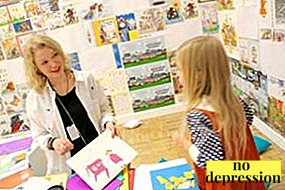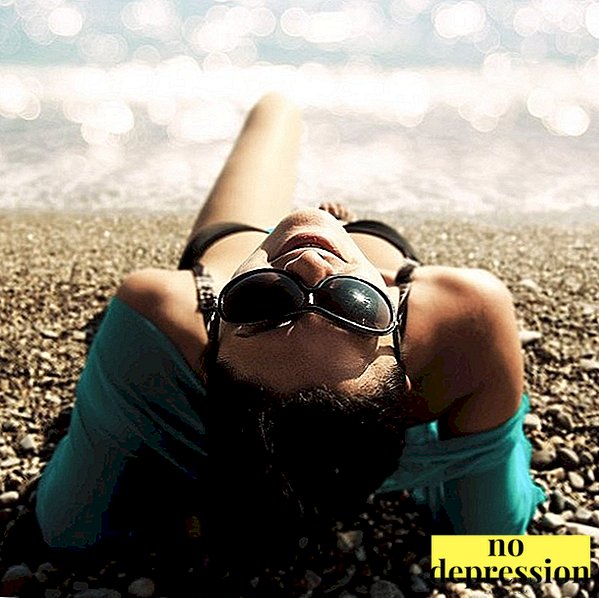Creative work can help in the fight against stress, depression, various disorders, phobias, improve self-esteem, show the inner world of the patient.
Therefore, art therapy is actively used as auxiliary method in the treatment of mental illness.
To achieve a rapid improvement in condition due to art therapy, exercise should be performed regularly.
What it is?

Art Therapy - a branch in psychocorrection and psychotherapy, which uses creativity as a psychotherapeutic tool.
Information about art therapy from history:
- The founder of this trend is Adrian Hill, a British artist who lived in the twentieth century. In the late thirties, in the process of treating tuberculosis, he discovered that drawing allowed him to feel better. In 1938, Adrian began to teach drawing patients (mostly wounded by the military) and noticed that creativity allows not only to distance himself from sensations associated with diseases, but also significantly improves overall mental well-being.
- For the first time the definition of "art therapy" was used by Adrian Hill in 1942. In 1945 his book was published. "Art against disease."
- According to psychoanalytic views, art therapy allows patients redirect unspent domestic energy to socially approved areastherefore, the mental state improves. The process of redirecting energy (including sexual energy) is called sublimation.
Art therapy helps not only those whose mental state is not in order, but also to psychologists and psychotherapists: they get an opportunity to better understand the patient's well-being, to assess his mood.
This makes it possible find the best approach to treatment.
Also, art therapy continues to be used as ancillary care for people suffering from serious physical illnesses: it helps them to get away from pain and discomfort, to feel their own importance and to maintain mental health.
Theoretical basis

Patients taking art therapy courses draw, sculpt, listen to music, play musical instruments, write and read works of art, dance and so on.
In the process they learn to enjoy their own activities, accept yourself and your shortcomings, throw out negative emotions, which leads to an improvement in their mental well-being.
Art therapy is considered one of the most effective treatments for mental disorders. This direction can help people of any age, even children of early preschool age, because it is easy to adapt.
Currently, there is a tendency to create flexible art-therapeutic systems that are suitable for working with a group of people.
Earlier this direction was more often applied in individual work with the patient. It is often used to help small childrenbecause their drawings can tell about their state of health no less, or even more than their behavior.
Any kind of art can have a favorable effect on the condition of patients, so you can not only draw or do modeling from plasticine, but also burn it on wood, lay out a mosaic, do sewing, knitting, embroidery: it all depends on the financial possibilities of patients and the clinic.

Do not confuse art therapy and creative activities in principle: art-therapeutic methods are applied by a psychologist or a psychotherapist, and it is he who ensures that classes bring the necessary results and have the correct structure.
Currently, there are several main areas of art therapy, including the most famous ones: isotherapy, music therapy, and bibliotherapy.
Principles
Principles underlying art therapy:
- Praise, approval. Warm and sincere words can support the patient's motivation, make him understand that what he is doing is important. The patient himself should also learn to praise himself, even if he (partly due to a mental illness) never does. Self-praise can be a little detached from the theme of art, for example: "I am a good fellow, because I forced myself to do drawing, and now I have a good mood."
Evaluative judgments (bad-good) should be avoided as much as possible, both with praise from the outside and with self-praise: this can aggravate patients' well-being, make them hate themselves and their abilities.
Examples of praise: "This is an interesting idea", "A very beautiful combination of colors."
- Lack of sample. This principle is partly in touch with the subject of value judgments: if there is a sample, then it is perceived as good, then, for which quality it is necessary to equal.
 And people who have turned out worse or not too similar, may feel bad. Art therapy is aimed not at getting the best results, but at help, so these points should be excluded. Psychologists offer patients a topic and usually say that they should draw as they want, based on fantasy.
And people who have turned out worse or not too similar, may feel bad. Art therapy is aimed not at getting the best results, but at help, so these points should be excluded. Psychologists offer patients a topic and usually say that they should draw as they want, based on fantasy. - Emotional inclusion of people leading the lesson. It is important for psychologists not only to give a topic and keep silent until the end of the lesson, but to observe the process, to praise, to talk.
- Maintain a welcoming atmosphere in the group. Rules must be defined that will help all participants feel comfortable.
There should always be an opportunity to express a personal opinion and not get aggression, therefore it is important to refrain from personal transitions.
- The right to make a mistake. It is important for psychologists to remind patients that they may be wrong, draw, sculpt not well enough, respond inappropriately, and so on. Patients themselves should also be reminded of this as often as possible.
- Intra-group dialogues. Friendly conversations relating to art in general, the topics of the lesson will help to rally patients and give them the opportunity to feel good, protected. Everyone who wishes should always have the opportunity to speak.
- Rituals. At the beginning and at the end of the lesson, a certain ritual (the same action) must be performed: for example, at the end, patients can, passing the pencil to each other, tell about what gave them the lesson.

Many people with mental illness are engaged in self-flagellation: “I will not succeed”, “I am mediocrity”, “I disgustingly draw and sculpt, so there is no point in it”.
This is a symptom of the disease, which is manifested in other areas of life, so you need to work with it.
The psychologist should make it clear to every patient undergoing art therapy that quality is irrelevant and that sense of art therapy in another: to enjoy, to lighten the mood, to throw out the accumulated negative emotions.
Art therapy may not be intragroup, but individual: a psychologist or psychotherapist gives the patient a task, and he performs it in his office or at home, in a comfortable environment.
Targets and goals
The main goals and objectives of art therapy:
- reduction or elimination of pathological symptoms, including anxiety, fears, self-hatred, sense of hopelessness, irritability, psychosomatic manifestations;
- splashing out accumulated negative emotions, relieving mental stress;
- formation of adequate self-esteem;
- improvement of communication skills, support for patients who, during the course of their illness, have acquired some degree of social disintegration, because of which life in society is difficult for them;
- development of creative abilities;
- the fight against pathological perfectionism, the formation of the installation that it is normal to err;
- improving cognitive skills, especially attention.
Art therapy is also aimed at formation of the ability to bring any business to the end.
Methodology in the work of a psychologist

Methods of art therapy are actively used by modern psychologists, especially those who work with children and adolescents.
Usually this therapy is used as an auxiliary method, since most of the mental problems of clients require an integrated approach.
Psychologists working in educational institutions, especially in kindergartens, may offer children to pass drawing tests: draw a house, a tree or a family.
After the drawings are ready, the psychologist collects them and analyzes them: evaluates the details, colors. This art therapy method allows you to quickly identify deviations in the mental health and intelligence of children.
Pictorial tests can be used not only to detect children with mental problems, but also to check how effective psychotherapeutic assistance has been.
The main methods of art therapy: drawing, modeling, music, origami, working with wood, stone, writing textual works (poems, prose), dance art, singing, pottery.
The most famous techniques and techniques of art therapy are:
- Mandala method. Mandalas are symmetrical images found in Buddhism and Hinduism. Patients paint ready-made drawings of mandalas and draw them independently. The colors that the patient used when working with the mandala can tell a lot about his mental well-being.
- Gestalt therapy techniques. Gestalt therapy - the direction, which is based on a mechanism consisting of experiment and phenomenon: the patient is offered to set up an experiment and observe what will happen. Any reaction to the experiment directly during its conduct is a phenomenon. Art therapy is an integral part of gestalt therapy techniques, since it allows experiments to be performed using art means.
- Methods of Evgenia Belyakova (arthynthesis therapy, or AST). In this direction, versification, theater, drawing, theatrical improvisation, rhetoric are applied. Founder of the direction is the head of the training program for art synthesizing therapists. The main goal of the technique is to teach patients to release experiences.

Art therapy can be used in combination with various psychotherapeutic techniquessuch as cognitive behavioral psychotherapy, family psychotherapy, psychological counseling.
Art therapy, used as part of psychological counseling, helps the patient to get deeper into the problem, feel it and find a way out.
To become an art therapist, you should either get additional education (to improve qualification), or to complete the master's level program.
Types and directions
The main directions and techniques:
- Pictorial therapy. This is the most common therapeutic direction, since it is the most accessible and with its help it is easy to find an approach to people of any age. By painting therapy include painting, painting, familiarization with the painted works of art and their discussion.
- Bibliotherapy Includes reading and discussion of text works. Books are selected so that they can help the patient to experience any personal experiences.
- Fairy tale therapy. A variety of bibliotherapy, mainly used to work with young children. However, complex fairy tales, myths, legends can be suitable for working with more adult patients.
Fairy tales in a metaphorical form convey to the reader important thoughts that need to be noticed and analyzed.
- Music therapy. Music is able to launch associative chains in patients, helping them to open up. She is able to calm or, on the contrary, mobilize, cause some feelings, fantasies. As part of music therapy, patients not only listen to music, but also discuss it, learn new things.
- Dance movement therapy. Perfect for working with children, most of whom are extremely active and will easily engage themselves in dancing. Movement to music allows you to release negative experiences and get a lot of positive emotions.
- Dramatherapy. This is a variety of drama, staging, plays, acting out certain plots.

Also, art therapy is divided into:
- Passive. It includes only the study of ready-made works of art - listening to music, viewing paintings, sculptures - and the subsequent discussion. Allows you to save patients from additional anxiety about the fact that they will do poor-quality work.
- Active. It includes the direct creation of works of art: drawings, crafts, poems, prose, and so on.
The following methods are most suitable for individual work: drawing therapy, music therapy, bibliotherapy, fairy-tale therapy. Other techniques are well suited for group classes.
Exercises for children and adults
Exercises for children:
- Strokes The child is offered at a convenient pace for him to put on the sheet of paper short lines. This allows you to splash out irritability and helps to calm. Suitable for preschoolers.
- Drawing on a wet sheet. The child, taking a brush or a sponge in his hands, puts on a wet sheet of paper lines, spots, stripes and whatever he wants, getting an opportunity to observe how the paint spreads nicely. This activates his imagination and has a relaxing effect. Suitable for preschoolers.
- Application to the vessel. The child decorates the container with pieces of paper. You can add grains, beads, beads. Suitable only for older preschoolers and older children.
Children can be offered to paint with finger paints, use watercolor (preferably honey) paint.
When working with children under three years old, it should be remembered that they may accidentally swallow small parts (grains, beads), shove them in their ears and nose, therefore, they should be protected as far as possible from activities involving interaction with small objects.
Exercises for adults:
- Draw a picture in complete darkness. It will be an amazing experience that will surely be a pleasure. When you find yourself in the dark, take your time. Focus on the sensations that are available to you, and gradually draw.
- Work with garbage. Many people have various unnecessary trifles in the tables: paper clips, pieces of paper, old newspapers, notes. You should dig into the back streets of your boxes and pull out all that can be labeled as garbage. After that, inspect the findings and determine which of them seem to you the personification of the past, from which you want to get rid of. From the selected fragments make a collage. After it is recommended to burn.
- Write a story about a hero or heroine. Sit comfortably, think carefully and write your story about how he or she overcomes difficulties and how his / her life is changing for the better.

Art therapy allows significantly improve the mental state of patientstherefore it is actively used in most developed countries of the world. To art therapy therapy was successful, you should listen to the recommendations of the therapist and often praise yourself.
Features of the use of art therapy:

 And people who have turned out worse or not too similar, may feel bad. Art therapy is aimed not at getting the best results, but at help, so these points should be excluded. Psychologists offer patients a topic and usually say that they should draw as they want, based on fantasy.
And people who have turned out worse or not too similar, may feel bad. Art therapy is aimed not at getting the best results, but at help, so these points should be excluded. Psychologists offer patients a topic and usually say that they should draw as they want, based on fantasy.

